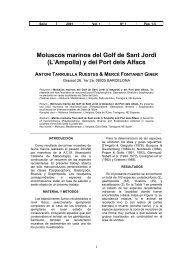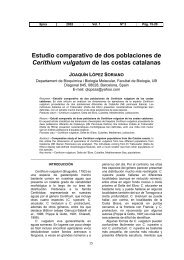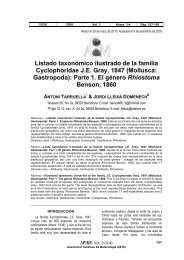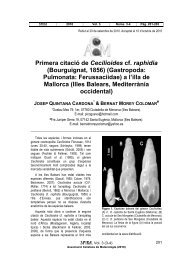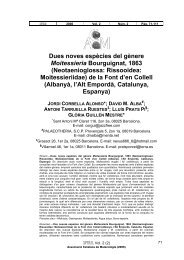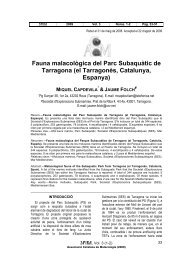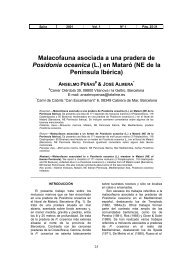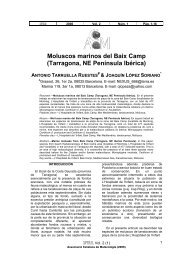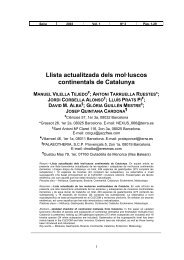You also want an ePaper? Increase the reach of your titles
YUMPU automatically turns print PDFs into web optimized ePapers that Google loves.
68<br />
David M. Alba, Antoni Tarruella, Lluís Prats, Glòria Guillén & Jordi Corbella<br />
Cochliopids: This family is distinguished from the<br />
Hydrobiidae. The Mediterranean species of Heleobia present<br />
in Catalonia corresponds to H. (Semisalsa) macei, instead of H.<br />
(S.) stagnorum.<br />
Valvatids: Several subgenera are distinguished within<br />
Valvata, and amongst the former, Cincinna is provisionally<br />
employed until its nomenclatural status is clarified. The taxon<br />
previously referred to Valvata (Tropidina) pulchella in<br />
Catalonia corresponds to V. (T.) macrostoma, despite the fact<br />
that the former taxon is also a synonym of V. (Cincinna)<br />
piscinalis. The latter is considered a monotypic species.<br />
Limneids: Radix auricularia is no longer considered a<br />
polytypic species. The taxa previously recorded in Catalonia as<br />
Radix ovata and R. peregra are attributed to R. balthica, the<br />
two former being merely considered ecophenotypic<br />
morphotypes.<br />
Physids: Haitia acuta, previously known as Physella<br />
(Costatella) acuta, and currently attributed to Physa by some<br />
authors, is considered an introduced species of North<br />
American origin.<br />
Planorbids: Gyraulus cf. chinensis is considered an introduced<br />
species. The genera Ferrissia and Ancylus are maintained<br />
within the Planorbidae instead of being classified into<br />
different families. Bulinus truncatus is considered a polytypic<br />
species. It is considered that the species of Ferrissia present in<br />
Catalonia corresponds to the invasive species of American<br />
origin F. fragilis. Ancylus fluviatilis s.l. is considered a complex<br />
of cryptic species, with A. fluviatilis s.s. not being represented<br />
in Catalonia, whose Ancylus populations are provisionally<br />
attributed to A. cf. rupicola.<br />
Ellobiids: This family Ellobiidae includes the subfamily<br />
Carychiinae, previously considered a separate family of its<br />
own. Myosotella denticulate and M. myosotis are maintained as<br />
distinct species.<br />
Azecids: Despite recent attempts to include the family<br />
Azecidae as a subfamily of the Cochlicopidae, these taxa are<br />
considered two distinct families here, in recognition of recent<br />
molecular data.<br />
Orculids: Sphyradium doliolum klemni is considered an<br />
objective junior synonym of S. doliolum, with no distinct<br />
subspecies.<br />
Argnids: It is not possible to determine if the citation of<br />
Argna ferrari from Catalonia corresponds to the nominotypical<br />
subspecies or to A. f. blanci, being reported in the updated list<br />
as A. ferrari ssp., although this taxon might be no longer<br />
present in Catalonia.<br />
Pupillids: Pupilla bigranata and P. muscorum are retained as<br />
distinct species.<br />
Pyramidulids: Pyramidula umbilicata is added to the list of<br />
Catalan malacofauna.<br />
Chondrinids: Chondrina farinesii is no longer considered a<br />
polytypic species, Chondrina massotiana massotiana is added to<br />
the list of Catalan malacofauna, and Chondrina farinesii<br />
sexplicata is now referred to C. massotiana sexplicata. The<br />
following Chondrina species are considered valid and present<br />
in Catalonia (some of them not formally described yet):<br />
Chondrina aguilari, C. soleri (endemic), C. dertosensis<br />
(endemic), Chondrina sp. 2 in Kokshoorn et Gittenberger,<br />
2010 (endemic) and Chondrina sp. 6 in Kokshoorn et<br />
Gittenberger, 2010 (endemic). Abida pyrenaearia and A.<br />
vergniessiana, both present in Catalonia, are considered<br />
distinct species instead of subspecies. Abida occidentalis,<br />
previously inadvertendly omitted from the list of Catalan<br />
malacofauna, is added to the revised list. With regard to the<br />
polytipic species Abida secale, the following subspecies are<br />
added to the list of Catalan malacofauna: the endemic A. s.<br />
tuxensis, as well as the recently-described taxa A. s. ionicae, A. s.<br />
merijni (endemic), A. s. peteri (endemic) and A. s. vilellai<br />
(endemic).<br />
Vertiginids: Vertigo lilljeborgi is added to the list of Catalan<br />
malacofauna. The previous citation of Vertigo modesta from<br />
Catalonia corresponds to the subspecies V. m. arctica.<br />
Enids: Zebrina detrita is considered a polytypic species, with<br />
the nominotypical subspecies being present in Catalonia.<br />
Clausiliids: Papillifera papillaris is maintained as a junior<br />
synonym of Papillifera bidens, and P. b. affinis is added to the<br />
list of Catalan malacofauna. Macrogastra attenuata lineolata is<br />
also added to the list of Catalan malacofauna; we provisionally<br />
retain the use of the binomen Macrogastra attenuata, although<br />
it is possible that M. basileensis should be employed instead for<br />
this taxon. Macrogastra rolphii is considered a polytypic<br />
species, recorded in Catalonia by the nominotypical<br />
subspecies, M. r. rolphii. Clausilia dubia geretica is now referred<br />
to C. dubia dubia, until the former is adequately characterized.<br />
Ferussaciids: The taxon previously referred to as<br />
Hohenwartiana disparata is now referred to Cecilioides (C.)<br />
eucharista. The taxon previously cited as Cecilioides (Terebrella)<br />
vandalitiae is attributed to C. (C.) acicula.<br />
Discids: Discus rotundatus is not considered a polytypic<br />
species, with D. r. omalisma being considered a morphotype<br />
with no taxonomic validity at the subspecies rank.<br />
Euconulids: Euconulus (E.) trochiformis is added to the list of<br />
Catalan malacofauna.<br />
Gastrodontids: Zonitoides jaccetanicus is provisionally<br />
considered endemic from Catalonia.<br />
Oxychilids: Ortizius is considered a valid subgenus of<br />
Oxychilus. No subspecies are distinguished in Oxychilus<br />
cellarius, with O. c. montsicci being considered a junior<br />
subjective synonym of the former. No well-established<br />
subspecies can be distinguished for Oxychilus draparnaudi. The<br />
genera Morlina and Mediterranea are maintained, instead of<br />
being considered junior synonyms of Oxychilus. No subgenera<br />
have been distinguished within Mediterranea, due to<br />
nomenclatural problems associated to the validity of Riedelius,<br />
which on the basis of its type species is an junior synonym of<br />
Mediterranea s.s. Subspecies are distinguished within<br />
Mediterranea hydatina, with the nominotypical one being<br />
represented in Catalonia. Morlina glabra harlei is provisionally<br />
considered an endemic subspecies from Catalonia.<br />
Limacids: Limax and Limacus are maintained as distinct<br />
genera, although other authores merely distinguish them as<br />
subgenera.<br />
Agriolimacids: It is not possible to verify the taxonomic<br />
identity of the previous citation of Deroceras (D.) hydrobium in<br />
Catalonia, and accordingly it has been removed from the list<br />
of Catalan malacofauna. Deroceras tarracense is transferred<br />
from the nominotypical subgenus to Plathystimulus.<br />
Arionids: The taxon previously referred to as Arion (A.)<br />
lusitanicus sensu Van Regteren Altena, 1956 is here named A.<br />
(A.) vulgaris, in strict application of the Principle of Priority<br />
and given the fact that the latter name is being increasingly<br />
applied in the literature.<br />
Cochlicellids: The Cochlicellidae, previously considered a<br />
subfamily of the Hygromiidae, are here considered a distinct<br />
family. Prietocella is considered a subgenus of Cochlicella,<br />
instead of a distinct genus or a junior synonym of the latter.<br />
Hygromiids: Euomphalia strigella ruscinica is maintained as a<br />
valid subspecies of E. strigella. Although Theba cantiana has<br />
been sometimes cited from Catalonia, on the basis of<br />
published citations it is not possible to unambiguously confirm<br />
the presence of this species in Catalonia, and hence it has not<br />
been reported in the updated check-list of Catalan<br />
malacofauna. No subgenera are distinguished in Trochoidea,<br />
whereas Xerocrassa is considered to contain several subgenera,<br />
although this rank has not been specified in the Catalan<br />
species of the latter genus, because they subgeneric attribution



